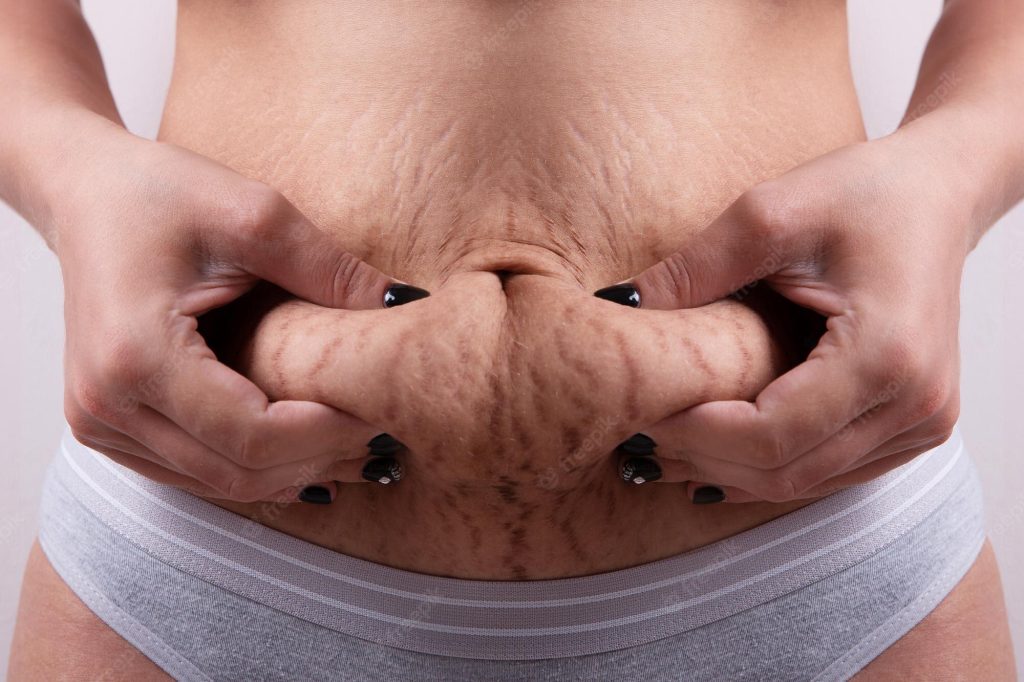
Stretch marks are a common occurrence during pregnancy, childbirth, and weightlifting. They are caused by the stretching of the skin as it grows and changes shape. There is no one-size-fits-all solution to preventing stretch marks, but following some simple tips can help.
Contents
What are Stretch Marks?
Stretch marks are a cosmetic problem that can develop on the skin during pregnancy, weight loss, exercise, and other physical activity. They are caused by the stretching of the skin and normally fade away over time.
Stretch marks may occur anywhere on the body but are most common on the abdomen, breasts, hips, thighs, and calves. Rarely, stretch marks can occur on other areas of the body such as the face or neck. Stretch marks may be light or dark in color and may vary in size from tiny dots to large patches.
There is no known cure for stretch marks, but there are treatments that can help relieve their symptoms. If you experience stretch marks, it is important to seek out professional advice as soon as possible so that you can begin treatment early enough to see some improvement. There are also a number of products available on the market that can be used to prevent or reduce the appearance of stretch marks.
If you’re concerned about your stretch marks and would like to know more about them or find out more about treatments available, please visit our website or contact us for more information.
Types of Stretch Marks
Stretch marks are caused by stretching the skin beyond its natural elasticity. There are three main types of stretch marks: epidermal, dermal and subcutaneous. Epidermal stretch marks form on the outer layer of the skin; dermal stretch marks form beneath the surface layer of the skin; and subcutaneous stretch marks are found beneath the skin.
Some factors that may contribute to the development of stretch marks include: genetics, age, weight, breastfeeding, exercise, trauma, sun exposure, and pregnancy. There is no one cure for stretch marks, but there are a variety of treatments that may help lessen their appearance or prevent them from developing in the first place. Some common treatments include topical creams, light therapy, surgery, and Botox injections.
Causes of Stretch Marks
Stretch marks are a type of scar that can form on the skin from vigorous stretching or compression. They may occur anywhere on the body, but are most commonly seen on the thighs, belly button, breasts, and hips. There are many causes of stretch marks, but the most common ones are pregnancy, weightlifting, and childbirth.
Unfortunately, there is no one stretch mark prevention method that works for all people. However, there are a few things you can do to reduce your risk of getting stretch marks:
– Avoid strenuous activity during your heaviest periods (before and after pregnancy).
– Make sure your skin is well-hydrated before stretching.
– Avoid using harsh soaps and shampoos when you’re trying to prevent stretch marks. Instead use gentle soap and moisturizers that don’t contain SLS (sulfates) or SLES (sodiumLauryl sulfate).
– Get plenty of exercise but avoid using over-the-counter creams or lotions that contain hormones or steroids. These can cause stretch marks in some people.
How to Prevent Stretch Marks
There are a few things you can do to prevent stretch marks from developing on your skin. The following tips will help keep your skin healthy and elastic, preventing the formation of stretch marks:
• Drink plenty of water: Keeping your body well-hydrated is essential for keeping your skin looking its best. Drinking plenty of water helps keep your skin’s surface hydrated and in good condition, which helps to prevent the formation of stretch marks.
• Eat a balanced diet: Eating a balanced diet is also essential for keeping your skin healthy and elastic. A good diet includes both protein and carbohydrates, which help to feed the cells in your skin and maintain their elasticity.
• Avoid using harsh soaps: Harsh soaps can strip the protective oils from your skin, leading to dryness and the development of stretch marks. Instead, opt for gentle cleansers that are composed of natural ingredients that won’t damage your skin.
What are stretch marks?
Stretch marks are markings on the skin that are caused by stretching and tearing of the skin. They can appear anywhere on the body but are most commonly seen on the breasts, buttocks, thighs, and abdomen.
There is no one-size-fits-all approach to preventing stretch marks, as the severity and location of stretch marks will vary from person to person. However, some common methods for preventing stretch marks include: stretching regularly, avoiding excessive weight gain or loss, using sunscreen and moisturizer regularly, and wearing loose-fitting clothing.
Types of Stretch Marks
There are many types of stretch marks, but they all have one common denominator: stretching occurs over time. Stretch marks can form on any skin area that has been stretched repeatedly, including the skin over your stomach (abdomen), breasts, hips, and thighs. They can also form on your back, neck, and arms.
Stretch marks can occur during pregnancy or while you’re nursing. They can also happen when you’re exercising or when you have large amounts of skin pulled in one direction for a prolonged period of time. Some people get stretch marks after weightlifting or after surgery.
There is no surefire way to prevent stretch marks, but there are some things you can do to reduce their likelihood. You can avoid stretching your skin too much if you want to avoid getting stretch marks. You can also avoid exercising if you’re pregnant or nursing. And you can avoid having surgery if possible.
How to prevent stretch marks
Stretch marks are a common side effect of pregnancy and weight gain, but there are ways to prevent them. Here are some tips:
1. Make sure you’re getting enough protein and calcium. These nutrients help to keep skin elasticity high which reduces the risk of stretch marks.
2. Avoid sun exposure. UV light can cause skin cells to break down, which can lead to stretch marks.
3. Wear lightweight clothing that fits snugly. This will prevent your skin from stretching too much and potentially creating stretch marks.
4. Keep your skin hydrated. Moisture helps to reduce the appearance of stretch marks, as well as keeping your skin healthy overall.
5. Apply sunscreen regularly while you’re pregnant or while you’re trying to avoid getting stretch marks. Sunscreen protects your skin from the damaging effects of the sun, including those that can cause stretch marks.
Conclusion
Stretch marks can be an emotionally devastating experience, but there are ways to prevent them from happening in the first place. By following these simple tips, you can help keep your skin healthy and elastic so that stretch marks don’t form. This is a long-term process, but it’s worth it to avoid one of the most common birthmarks. Thanks for reading!

